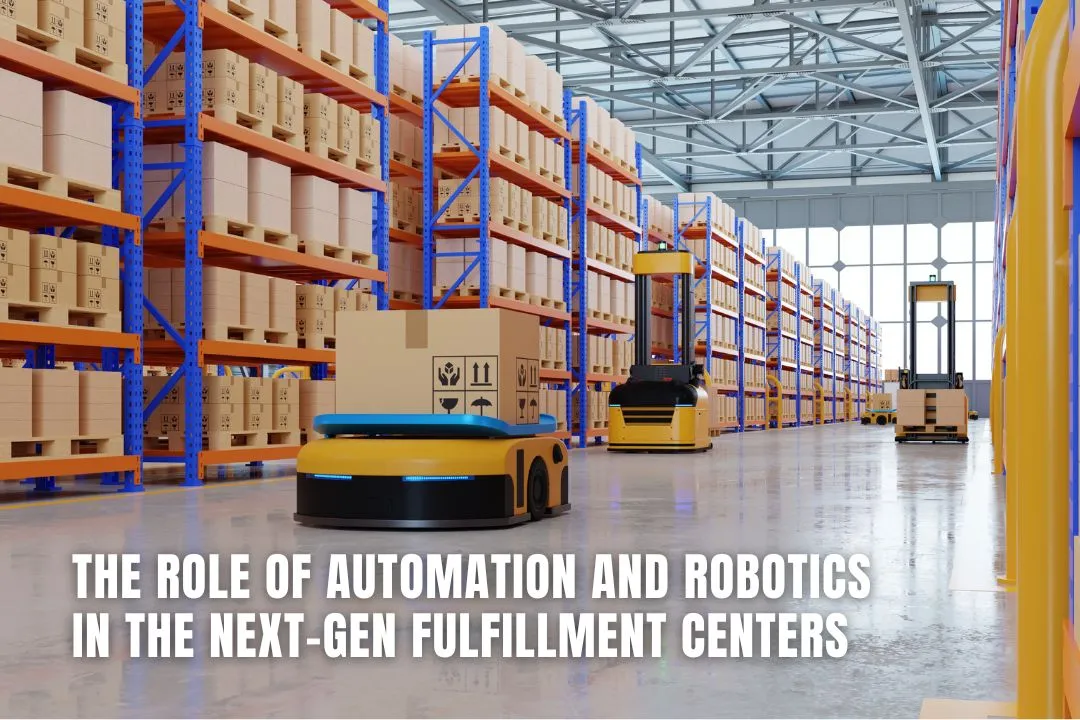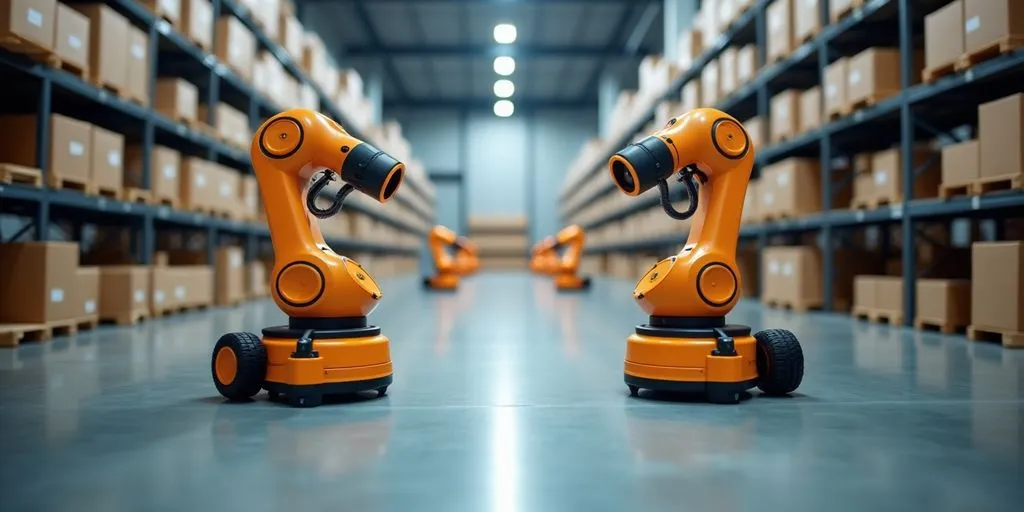The Role of Automation and Robotics in the Next-Gen Fulfillment Centers
November 11, 2024

In today's fast-paced world of online shopping, fulfillment centers play a crucial role in getting products to customers quickly and accurately. The rise of automation and robotics is transforming these centers, making them more efficient and effective. This article explores how these technologies are reshaping the landscape of fulfillment centers, enhancing operations, and paving the way for future advancements.
Key Takeaways on Automation and Robotics for Fulfillment Centers
- Fulfillment centers have evolved with automation: Initially relying on manual labor, fulfillment centers now use automation to improve efficiency, reduce errors, and meet growing consumer demands.
- Robotics are revolutionizing fulfillment processes: Robots, including picking, transport, and sorting machines, streamline operations, speeding up tasks and enhancing accuracy in warehouses.
- AI and machine learning boost robotics performance: AI enables robots to adapt to changing environments and optimize tasks, while machine learning analyzes data to predict trends and improve decision-making.
- Cobots enhance human-robot collaboration: Cobots are designed to work alongside humans, performing repetitive or heavy tasks, thereby increasing efficiency, reducing injuries, and improving worker satisfaction.
- Training and upskilling are essential: As automation and robotics are integrated, workers must be trained to use these technologies effectively, ensuring a smooth transition and new skill development.
- Automation reduces operational costs: While initial investments can be high, automation and robotics help lower long-term costs by speeding up processes and minimizing errors in fulfillment tasks.
- Future technologies will continue to transform fulfillment: Emerging innovations like drones, AI-driven decision-making, and sustainable automation solutions will further shape the future of fulfillment centers, improving speed and reducing environmental impact.
Register Your LLC
Company Registration
START NOWTransforming Fulfillment Centers with Automation

Historical Overview of Fulfillment Centers
Fulfillment centers have changed a lot over the years. In the past, they relied heavily on manual labor. Workers would walk through large warehouses, picking items from shelves and packing them for shipment. This method was slow and often led to mistakes. As online shopping grew, the need for faster and more accurate order processing became clear.
The Shift from Manual to Automated Systems
The move to automation began with simple machines like conveyor belts and sorting systems. These tools helped speed up the movement of products. For example, many centers now use automated storage and retrieval systems (ASRS) to save space and quickly find items. This shift has greatly improved efficiency and reduced human errors.
Key Drivers for Automation Adoption
Several factors are pushing fulfillment centers to adopt automation:
- Increased demand for faster deliveries.
- The need to reduce operational costs.
- The desire to minimize errors in order processing.
Automation is not just a trend; it’s a necessity for modern fulfillment centers to keep up with consumer expectations.
In summary, automation is transforming fulfillment centers by making them faster, more efficient, and less prone to mistakes. As technology continues to advance, we can expect even more changes in how these centers operate.
Robotics Revolutionizing Fulfillment Processes
Introduction to Robotics in Fulfillment
Robotics is changing the way fulfillment centers operate. These machines are not just tools; they are game changers. They can perform tasks that were once only possible for humans, making processes faster and more accurate.
Types of Robots Used in Fulfillment Centers
In fulfillment centers, various types of robots are utilized:
- Picking Robots: These robots select items from shelves using advanced sensors.
- Transport Robots: They move products around the warehouse, optimizing routes to save time.
- Sorting Robots: These help categorize products, ensuring they reach the right destinations quickly.
Impact of Robotics on Efficiency and Accuracy
The introduction of robotics has led to significant improvements in efficiency and accuracy. Here’s a quick look at the benefits:
The integration of robotics in fulfillment centers not only enhances productivity but also helps businesses future proof their ecommerce operations, ensuring they meet growing customer demands effectively.
AI and Machine Learning: The Brain Behind Automation
Role of AI in Enhancing Robotics
AI is crucial for making robots smarter and more efficient. With AI, robots can learn from their surroundings and improve their tasks over time. This means they can adapt to new challenges and optimize their operations. For example, AI helps robots predict order volumes, allowing them to adjust their tasks in real-time. This adaptability is essential for keeping up with changing demands in fulfillment centers.
Machine Learning for Predictive Analytics
Machine learning is a type of AI that allows systems to learn from data. In fulfillment centers, it helps in:
- Analyzing order patterns to predict future needs.
- Adjusting robot tasks based on trends, like prioritizing popular items.
- Continuously improving efficiency by learning from past operations.
Real-Time Decision Making with AI
AI enables robots to make quick decisions on the spot. For instance, if a product is out of stock, the system can reroute tasks immediately. This ensures that operations run smoothly without delays.
The integration of AI and machine learning in fulfillment centers not only boosts efficiency but also enhances accuracy, leading to better customer satisfaction.
In summary, AI and machine learning are transforming fulfillment centers by making robots more capable and responsive to real-time needs. This technology is essential for the future of automated operations.
Human-Robot Collaboration in Modern Fulfillment Centers
Understanding Cobots and Their Functions
In today's fulfillment centers, cobots (collaborative robots) are changing the way we work. These robots are designed to work alongside humans, helping with tasks that are repetitive or heavy. This means that workers can focus on more complex jobs while robots handle the heavy lifting. Cobots are safe to work with and can help reduce workplace injuries.
Benefits of Human-Robot Collaboration
The collaboration between humans and robots brings many advantages:
- Increased Efficiency: Robots can work faster and more accurately than humans in certain tasks.
- Reduced Risk of Injury: By taking on heavy or dangerous tasks, cobots help keep workers safe.
- Better Job Satisfaction: Workers can engage in more meaningful tasks, leading to higher job satisfaction.
Training and Upskilling the Workforce
As robots become more common in fulfillment centers, training is essential. Workers need to learn how to work with these machines effectively. This includes:
- Understanding how to operate cobots safely.
- Learning to troubleshoot issues that may arise.
- Upskilling to take on more complex roles that require human judgment.
The future of fulfillment centers isn’t just about robots replacing humans. Instead, it’s about humans and robots working side by side, leveraging each other’s strengths.
In conclusion, the integration of cobots in fulfillment centers is not just a trend; it’s a significant shift towards a more efficient and safer working environment. As technology continues to evolve, the collaboration between humans and robots will only grow stronger, reshaping the landscape of warehouse operations.
Overcoming Challenges in Automation Integration
Initial Investment and Cost Considerations
Integrating automation into fulfillment centers can be expensive. Many companies face high upfront costs for technology and training. Here are some key points to consider:
- Budgeting: Companies should plan for both initial and ongoing costs.
- ROI Analysis: Evaluate the return on investment over time.
- Financing Options: Explore leasing or financing to spread out costs.
Addressing Job Displacement Concerns
As automation grows, some workers worry about losing their jobs. It’s important to focus on how automation can create new roles:
- Job Evolution: Many jobs will change rather than disappear.
- Upskilling: Training programs can help workers learn new skills.
- New Opportunities: Automation can lead to new job creation in tech and maintenance.
Ensuring Seamless Technology Integration
Integrating new systems can be tricky. Companies need to ensure that all technologies work well together. Here are some strategies:
- Flexible Communication Protocols: Support different protocols for better integration.
- User Experience Consistency: A consistent interface helps workers adapt quickly.
- Data Observability: Use data from robots to improve operations and decision-making.
The journey to automation is not just about technology; it’s about people and processes working together to create a better future.
Future Trends in Fulfillment Center Automation

Emerging Technologies on the Horizon
The future of fulfillment centers is bright, with new technologies set to change the landscape. Here are some key trends:
- Drones for inventory checks and deliveries.
- AI for smarter decision-making.
- Advanced robotics for improved efficiency.
The Role of Drones and Autonomous Vehicles
Drones and autonomous vehicles are becoming essential in fulfillment. They can:
- Speed up deliveries by bypassing traffic.
- Reduce costs associated with traditional delivery methods.
- Enhance inventory management by quickly scanning stock.
Sustainability and Automation
Sustainability is a growing concern. Automation can help by:
- Reducing waste through efficient processes.
- Lowering energy consumption with smart systems.
- Minimizing carbon footprints with eco-friendly technologies.
The integration of automation and robotics is not just about efficiency; it’s about creating a sustainable future for fulfillment centers. Embracing these trends will be crucial for businesses aiming to stay competitive in the evolving market.
Conclusion
In conclusion, automation and robotics are changing the way fulfillment centers work. These technologies help businesses keep up with the fast-paced world of online shopping. By using robots, companies can pack and ship products faster and with fewer mistakes. This not only makes customers happy but also helps businesses save money. As we look to the future, we can expect even more exciting changes in fulfillment centers. The combination of human workers and robots will create a more efficient and safer workplace. Overall, automation and robotics are not just trends; they are essential tools for success in the modern economy.
Frequently Asked Questions
What is the role of automation in fulfillment centers?
Automation helps speed up the process of storing, packing, and shipping products. It makes operations faster and reduces mistakes.
How do robots improve fulfillment processes?
Robots can pick and move items more accurately and quickly than humans. They help in sorting and transporting products within the center.
What is a cobot?
A cobot, or collaborative robot, is designed to work alongside humans. They handle repetitive or heavy tasks, allowing workers to focus on more complex jobs.
Are robots going to replace human jobs?
Not exactly. While robots take over certain tasks, they also create new jobs that require different skills, like managing and maintaining the robots.
How does AI contribute to fulfillment centers?
AI helps robots learn from their surroundings and make better decisions in real-time. It can predict what items will be needed and adjust tasks accordingly.
What are the future trends in fulfillment centers?
We can expect more advanced technologies like drones for deliveries, better AI systems for decision-making, and a focus on sustainability in operations.

